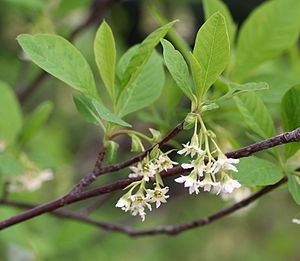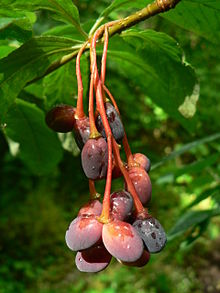Oemleria cerasiformis
| Oemleria cerasiformis | ||||||||||||
|---|---|---|---|---|---|---|---|---|---|---|---|---|

Oemleria cerasiformis , branch with simple leaves and inflorescences |
||||||||||||
| Systematics | ||||||||||||
|
||||||||||||
| Scientific name of the genus | ||||||||||||
| Oemleria | ||||||||||||
| Rchb. | ||||||||||||
| Scientific name of the species | ||||||||||||
| Oemleria cerasiformis | ||||||||||||
| ( Torr. & A.Gray ex Hook. & Arn. ) JWLandon |
Oemleria cerasiformis sometimes, Oregonpflaume called, is the only kind of monotypic genus Oemleria within the family of the rose family (Rosaceae). It isnative towestern North America .
description
Appearance and leaf
In Oemleria cerasiformis is a self-erect, loosely branched, deciduous, deciduous shrub , the growth heights of 1 to 5 feet reached or small tree reached, the stature heights of up to 6 meters. There are offshoots formed. The smooth bark is reddish-brown to dark-gray. The bark of the slender twigs is bare, initially green, later turning reddish-brown and has clearly visible orange lenticels . The terminal buds are 7 to 9 millimeters in length and the side buds are shorter.
The alternate leaves are arranged in a petiole and a leaf blade. The petiole is relatively short with a length of 5 to 15 mm. The simple, entire, gray-green leaf blade is 5 to 13 centimeters long and 2 to 5 centimeters wide and lanceolate, elliptical to narrowly obovate with a pointed base and a pointed upper end. The smooth leaf edge more or less rolls down. The underside of the leaf is lighter and sometimes fuzzy hairy and balding. The top of the leaf is bare. In spring it is one of the earliest deciduous species in its home range. The freshly sprouted leaves taste like cucumber. The stipules fall off early.
Inflorescence, flower and fruit
The flowering period in North America extends from April to May. Oemleria cerasiformis is usually dioecious, separate sexes ( diocesan ). There are 3 to 10 cm long, hanging, racemose inflorescences on short lateral branches . There are one or two bracts per inflorescence , but no bracts .
The fragrant, mostly unisexual, rarely hermaphrodite flowers are radial symmetry and five-fold with a double flower envelope . The flower cup (hypanthium) is 3 to 4.5 mm high. The five free, white, nailed petals are 3 to 6 mm long, with those of the male flowers being slightly larger than those of the female. In the male and hermaphrodite flowers there are three circles with five stamens each; they protrude somewhat from the corolla. There are five free carpels. Most of the flower cup and style wither soon after pollination.
One to five stone fruits form per flower. The stone fruit hanging on a red stem is egg-shaped and somewhat bean-shaped with a length of 5 to 15 mm. The blue-green frosted stone fruit is initially orange to yellow and turns blue-black when ripe.
Chromosome number
The basic chromosome number is x = 8.
Occurrence
The natural range of Oemleria cerasiformis is only in western North America . Oemleria cerasiformis is native to the southern part of the Canadian province of British Columbia and the western states of the United States in western Oregon , western Washington and northern California .
Oemleria cerasiformis occurs mainly in cool, damp forests on acidic to weakly alkaline, nutrient-rich, sandy-loamy to loamy, humus-rich soils . It is also found in bushes and hedges . It prefers light-shady locations with a mild winter. It thrives up to USDA Climate Zone 6a.
Systematics
The first description was in 1841 (1839) under the name ( Basionym ) Nuttallia cerasiformis by John Torrey and Asa Gray in William Jackson Hooker and George Arnott Walker Arnott : The Botany of Captain Beechey's Voyage , p. 337, plate 82. The genus Oemleria was created in 1841 set up by Ludwig Reichenbach in Das Herbarienbuch , p. 236. John Waddell Landon published the new combination to Oemleria cerasiformis in 1975 in Taxon , Volume 24, Issue 1, p. 200. The generic name Oemleria honors the German naturalist Augustus Gottlieb Oemler (1773-1852). The specific epithet cerasiformis means cherry-shaped. Another synonym for Oemleria cerasiformis (Torr. & A.Gray ex Hook. & Arn.) JWLandon is Osmaronia cerasiformis (Torr. & A.Gray) Greene .
Oemleria cerasiformis is the only species of the monotypic genus Oemleria from the tribe Osmaronieae in the subfamily Spiraeoideae within the family Rosaceae .
use
The fruits of Oemleria cerasiformis are eaten raw or cooked. The fruits, which look like small plums, are very bitter with an almond taste that decreases when fully ripe. The fruit has only a thin layer of pulp. It can be dried and stored over the winter. Caution is advised due to the toxicity of hydrogen cyanide.
The medical effects were examined. Plant parts were used in folk medicine.
swell
- Andreas Roloff, Andreas Bärtels: Flora of the woods. Purpose, properties and use . 3rd, corrected edition. Eugen Ulmer, Stuttgart (Hohenheim) 2008, ISBN 978-3-8001-5614-6 .
- Daniel Potter & Barbara Ertter: Entry of genus and species at Jepson eFlora .
Individual evidence
- ↑ a b c d e f g h i j k Andreas Roloff, Andreas Bärtels: Flora of the woods. Purpose, properties and use . 3rd, corrected edition. Eugen Ulmer, Stuttgart (Hohenheim) 2008, ISBN 978-3-8001-5614-6 .
- ↑ a b c d e f g h i j k data sheet at The Department of Forest Resources and Environmental Conservation at VirginiaTech . Retrieved March 8, 2013
- ↑ a b c d e f g h i j k l Daniel Potter & Barbara Ertter: Entry of genus and species at Jepson eFlora . Retrieved March 8, 2013
- ↑ a b c Oemleria cerasiformis in the Germplasm Resources Information Network (GRIN), USDA , ARS , National Genetic Resources Program. National Germplasm Resources Laboratory, Beltsville, Maryland. Retrieved March 8, 2013
- ↑ First description scanned at biodiversitylibrary.org .
- ↑ Entry in Tropicos . Retrieved March 8, 2013
- ↑ a b Entry in Plants for A Future . Retrieved March 8, 2013
- ^ Entry in Native American Ethnobotany - A database of plants used as drugs, foods, dyes, fibers, and more, by native Peoples of North America. . Retrieved March 8, 2013

